#Grafton St
Explore tagged Tumblr posts
Text
#OTD in 1669 – Molly Malone is purportedly christened in Dublin.
The song ‘Molly Malone’, also known as ‘Cockles and Mussels’ tells the story of an attractive fishmonger in Dublin named Molly Malone. The song tells how she died young of a fever and how her ghost still haunts the streets of Dublin where she plied her trade. The song is extremely popular in Ireland and elsewhere and is the unofficial anthem of Dublin. Almost every Irish artist has recorded…
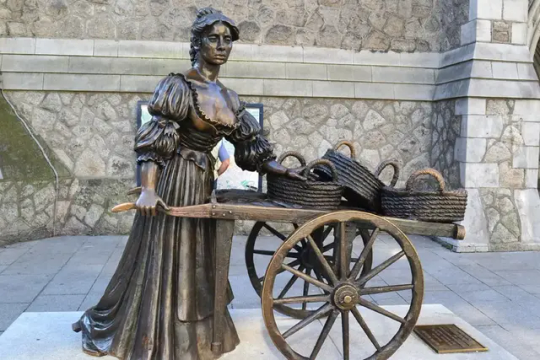
View On WordPress
#Baptism#Christened#Cockles and Mussels#Dublin#Dublin Tourist Office#Fever#Fishmonger#Grafton St#Ireland#Irish History#Lucas Tracks#Molly Malone#Statue#Suffolk St#Wheelbarrow
19 notes
·
View notes
Text

St Stephen's Green is a garden square and public park located in the city centre of Dublin, Ireland. The current landscape of the park was designed by William Sheppard. It was officially re-opened to the public on Tuesday, 27 July 1880 by Lord Ardilaun.
The square is adjacent to one of Dublin's main shopping streets, Grafton Street, and to a shopping centre named after it, while on its surrounding streets are the offices of a number of public bodies as well as a stop on one of Dublin's Luas tram lines. It is often informally called Stephen's Green. At 22 acres (8.9 ha), it is the largest of the parks in Dublin's main Georgian garden squares. Others include nearby Merrion Square and Fitzwilliam Square.
The park is rectangular, surrounded by streets that once formed major traffic arteries through Dublin city centre, although traffic management changes implemented in 2004 during the course of the Luas works have greatly reduced the volume of traffic. These four bordering streets are called, respectively, St Stephen's Green North, St Stephen's Green South, St Stephen's Green East and St Stephen's Green West.
Source and more in Wikipedia
#St Stephen's Green#garden square#public park#Dublin#Ireland#autumn#aerial#Grafton Street#main shopping streets#rectangular shape
3 notes
·
View notes
Text
clocking out after a long shift at the "being the bigger person and moving on" factory
#y'know how they say grief finds you in the middle of the street like sunlight through trees#clutching my chest in the middle of grafton st fr#yes maura this is prob about who you think it is#grrrrrrrrr#:(
1 note
·
View note
Text
To those celebrating their Irish heritage, and to those who just want to go out and party...
Blessings to you all!

Pinterest
#st patrick's day#irish blessing#my heart is somewhere on Grafton Street tonight#my heart is in the Curraugh
224 notes
·
View notes
Note


"Pizza Corner" intersection of Blowers st. and Grafton st. Halifax, Nova Scotia, Canada
24 notes
·
View notes
Text
I always forget about st Patrick's day... why are there Americans doing an accapella version of Hamilton on grafton Street 😭
#the vibes are evil#so many green hats#i dont care for american tourists ill be so real#every march i become the joker for a brief period#eadbh.txt#hi
8 notes
·
View notes
Text

Fureter et glaner des disques lors de l'ouverture du HMV Megastore sur Grafton St., à Dublin, le 8 décembre 1986.
27 notes
·
View notes
Text
In North Earl street especially LMAO
WHO in their right minds is putting one of those portal things in Dublin
#i walked past it yesterday and i was tempted to go take a look#but it was closed off or smt 🫤#i want to know the thought process behind this#that’s the last spot I would have picked lmfao#put it at St. Stephen’s Green or Grafton Street#but Talbot street????
1 note
·
View note
Text
medieval women week day 2: Favorite non-Queen or Queen-adjacent royal woman: Jacquetta of Luxembourg Duchess of Bedford and Mother to Queen Elizabeth Woodville




Jacquetta of Luxembourg was the eldest child of the French Count of St Pol; her family descended from Charlemagne and were cousins to the Holy Roman Emperor. She grew up with war between France and England raging around her.
John, Duke of Bedford was the youngest son of King Henry IV. Having lost his wife to plague in 1432, he arranged to marry the seventeen-year-old Jacquetta, who was his social equal by her birth. Although married for two years they were childless when John died in September 1435. The King instructed Jacquetta to come to England and ordered Sir Richard Woodville, to arrange it.
However, Jacquetta and Richard fell in love, but Richard was a poor knight, far below Jacquetta in social status. Nonetheless, they married secretly thus thwarting any plans King Henry may have had to marry her off to a wealthy English lord. Theirs was a morganatic marriage, where one of the partners, most often the wife, was socially inferior. Henry was enraged and fined the couple £1000. He did however allow their heirs to inherit, which was unusual for morganatic marriages in England.
Being the widow of Henry V’s brother and aunt to the King, royal protocol gave Jacquetta the highest rank at court of any female except Henry’s wife, Margaret of Anjou, to whom Jacquetta was related by marriage. She even ‘outranked’ the King’s mother and was referred to as the ‘Duchess of Bedford,’ retaining the title from her first marriage. Richard and Jacquetta lived in their manor house at Grafton Regis near Northampton producing fourteen children, the eldest, Elizabeth being born in 1437.
In 1448 Richard was created Lord Rivers: his advancement ensured his family supported Henry VI in the dynastic feuding of the Wars of the Roses. The situation changed with the Yorkist victory at the Battle of Towton in 1461 and the seizure of the throne by Edward IV. By the spring of 1464, Jacquetta’s daughter Elizabeth was a widow, her Lancastrian husband having been killed in 1461. Within a few months, Elizabeth was married to the young King Edward IV.
Jacquetta died in 1472 aged 56 and was buried at Grafton, though no record of her tomb survives. Recently, one legacy has come to light. Research by gene specialists indicates that Jacquetta was a carrier of the rare Kell-Antigen-Mcleod syndrome causing impaired fertility and psychotic behavioural changes in the male descendants of the family.
Written by Michael Long. I have over 30 years experience teaching History in schools and examiner History to A level. My specialist area is England in the 15th and 16th centuries. I am now a freelance writer and historian.
#medievalwomenweek#jacquetta of luxembourg#day 2#wars of the roses#the white queen#The painting at the bottom right isn't Jacquetta but it's how I love to picture her and Richard Woodville together. My favorite couple from#this era
14 notes
·
View notes
Text

AIA Dublin attended the protest against the the Zionist attack Gaza this Wednesday evening.
The Starry Plough was prominently displayed as the protest took over the city centre, from Leinster House to Grafton St, O'Connell Bridge to the Free State Department of Foreign Affairs.
Republican activists distributed leaflets opposing NATO and highlighting NATO's role in the Occupation of Ireland to those at the event.
As with the British Occupation of Ireland, NATO is also centrally involved in the Zionist Occupation of Palestine and its war against the Palestinian People.
From Ireland to Palestine- One Struggle Against Imperialism!
Saor Éire Anois- Saoirse Don Phalaistín 🇮🇪 🇵🇸

#aia#dublin#ireland#irish#class war#palestine#gaza#rafah#free palestine#freepalastine🇵🇸#fuck nato#antinazi#antizionist#nato allies#nato expansion#nato#antinato#ausgov#politas#auspol#tasgov#taspol#australia#fuck neoliberals#neoliberal capitalism#anthony albanese#albanese government#save palestine#i stand with palestine#palestine fundraiser
4 notes
·
View notes
Text
#OTD in 1949 – Birth of Thin Lizzy lead singer, Phil Lynott.
Image | When asked by a journalist what it felt like to be black and Irish, Phil quipped, “Kinda like a pint of Guinness”. Irish rock star, bassist, singer and founder of Thin Lizzy, Phil Lynott is born in England to single mom Philomena Lynott. At about age four, Lynott moved to Dublin to live with his maternal grandmother. Still in his teens, he played with Skid Row, (the Irish band featuring…

View On WordPress
#Bassist#Brush Shiels#Bruxelles#Dublin#Founder of Thin Lizzy#Gary Moore#Grafton St#Harry St#Irish Rock Star#Phil Lynott#Phil Lynott Bronze Statue#singer#Skid Row#Thin Lizzy#Whiskey in the JarEdit "1949 – Birth of Thin Lizzy lead singer
6 notes
·
View notes
Text





Busy Saturday. Kari and Alma cheered the Lady Cubans to a state title. Joseph won 2nd fastest car at the Pinewood Derby and Dave won a green beer for running the Grafton St Patty’s 5k.
4 notes
·
View notes
Text



October 18th 1541 saw the death of Margaret Tudor, English princess, former Queen consort of Scotland and sister of Henry VIII.
Maybe Margaret was destined to be Queen of Scotland, she was baptised on November 30th 1489, St Andrews day.
From an early age, Margaret was part of Henry VII’s negotiations for important marriages for his children and her betrothal to James IV of Scotland was made official by a treaty in 1502 even though discussions had been underway since 1496. Part of the delay was the wait for a papal dispensation because James’ great-grandmother was Joan Beaufort, sister of John Beaufort, who was the great-grandfather of Margaret Tudor. That made James IV and Margaret Tudor fourth cousins, which was within the prohibited degree. Patrick Hepburn, the Earl of Bothwell, acted as a proxy for James IV of Scotland for his betrothal to Margaret Tudor at Richmond in January 1502 before the couple was married in person in August 1503.
The Tudor writer Richard Grafton escorted Margaret to Scotland and it’s seems he wasn’t too taken with us, he later wrote….“Then this lady was taken to the town of Edinburgh, and there the day after King James IV in the presence of all his nobility married the said princess, and feasted the English lords, and showed them jousts and other pastimes, very honourably, after the fashion of this rude country. When all things were done and finished according to their commission the earl of Surrey with all the English lords and ladies returned to their country, giving more praise to the manhood than to the good manner and nature of Scotland.”
It’s amazing we survived as a race, let alone as Scots, given the mortality rate, even in cases where the mothers well better off, as in Margaret’s case, she had a horrible time trying to provide James IV with an heir. Her first pregnancy was in 1506 and she gave birth to a son, James, in February 1507 who lived about a year. Margaret next gave birth to a daughter in July 1508 who only survived for a few hours. In 1509, Margaret’s father died and her brother was now Henry VIII, the new king of England. Early in that year Margaret became pregnant once again and gave birth to another son, this one named Arthur, in October. However, this child also died at a young age, only nine months old.
Margaret’s next child was born on April 11, 1512 at Linlithgow and named James. This child, unlike all those before him, lived to adulthood and at little over a year old he was to succeed his father as James V. The Queen became pregnant yet again shortly afterwards and gave birth to another daughter, who died a few hours later.
It was during Margaret’s final pregnancy that James IV and the Flower of Scotland s, died on the battlefield at Flodden.
Margaret had thoughts of becoming regent for James V, but it was unheard of for women to rule, so needed a husband, unfortunately for her she chose a man seen by his counterparts as a fool. Her second husband was the powerful Scottish lord Archibald Douglas, 6th Earl of Angus. And so it was that John Stuart, Duke of Albany (a cousin to the king, and next in line to the throne after little Alexander’s death), was invited by the Scottish lords to be Regent. Albany had been living in France with his mother’s relatives and served three French kings - Charles VIII, Louis XII and Francis I. Albany arrived in Scotland in May 1515.
By this time Margaret was pregnant, yes again!. As an English woman among Scots she felt ill at ease and fled to England, James V had by this time been seized from her by the Lords. She gave birth to a daughter, Margaret Douglas in October. Margaret fell very ill after her daughter’s birth and nearly died, her Douglas abandoned his wife about this time and returned to Scotland. Margaret stayed in England for about a year before returning to Scotland under promise of safe conduct in June 1517.
The marriage of Margaret and Angus turned out to be disastrous. While he was in Scotland and she was in England, Angus had taken a mistress and was living off of Margaret’s Scottish revenues. The next few years were terrible for Margaret, with a horrible marriage, no money, no power and very little contact with her son James.
In 1524 Margaret, in alliance with the Earl of Arran, overthrew Albany’s regency and her son was invested with his full royal authority. James V was still only 12, so Margaret was finally able to guide her son’s government, but only for a short time as her husband, Angus took control of the young King. Margaret was finally able to attain an annulment of her marriage to Angus from Pope Clement VII and by the next April she had married her third husband, Henry Stewart, who had previously been her treasurer.
Things got serious for a time when her second hubbie, arranged for the third hubbie to be arrested as no permission had been granted by the Lords for this marriage, it was all resolved by 1528, whe James V was able to rule for himself, being 16. He appointed Henry Stewart as Lord Methven and proclaimed the Douglas’s as traitors, Angus fled to England.
Margaret’s relationship with her son was relatively good, although she pushed for closer relations with England, where James preferred an alliance with France. In this, James won out and was married to Princess Madeleine, daughter of the King of France, in January 1537. Madeleine was a poorly woman and died in July she is buried at Holyrood Abbey.
After his first wife’s death, James sought another bride from France, this time taking Marie de Guise.
By this same time, Margaret’s own marriage had followed a path similar to her second one when Methven took a mistress and lived off his wife’s money.
On this day in 1541, Margaret Tudor died in Methven Castle in Scotland, probably from a stroke. She was buried at the Carthusian Abbey of St. John’s in Perth, King James VI Hospital now occupies the it’s former location.
6 notes
·
View notes
Text
The Chocolate Dispensary, 1605 Grafton St Ste 102-A, Los Angeles (Echo Park), CA 90026

We need more chocolate dispensaries and fewer cannabis dispensaries. TCD offers hundreds of ethically and sustainably sourced craft chocolate products from makers around the world. They carry chocolate bars, truffles, baking chocolate, spreads, etc. I spotted some familiar brands (Vosges, Dandelion, Fossa) and many brands that I haven’t seen elsewhere.
There was a weird section for the adventurous palate, hard core for dark chocolate, etc.
They also do tastings (a flight of four chocolates is $5), with larger tastings on the weekends. And there’s a café that serves pour over coffee, French drinking chocolate, hot chocolate, and snacks. Find pastries on the weekends.
Chocolate tasting ($5): This was a fun way to try four new chocolates that ranged from dark chocolate to white chocolate. The chocolate pieces were already selected (you don’t choose them).
Service was excellent. Follow them on Instagram for a free truffle.
Madhu Mango Lassi White chocolate ($12): this chocolate bar is made with yogurt…eager to try.
Parking could be a challenge in this area, but if you love chocolate, you do need to visit.
5 out of 5 stars
By Lolia S.
#The Chocolate Dispensary#chocolate shop#chocolate bars#sustainable ethical sourced chocolate#Echo Park#chocolate tasting flight#French drinking chocolate
2 notes
·
View notes
Text
Qumblr meet up at the St Patrick's day ceili on grafton Street, we will dance together...
6 notes
·
View notes
Text
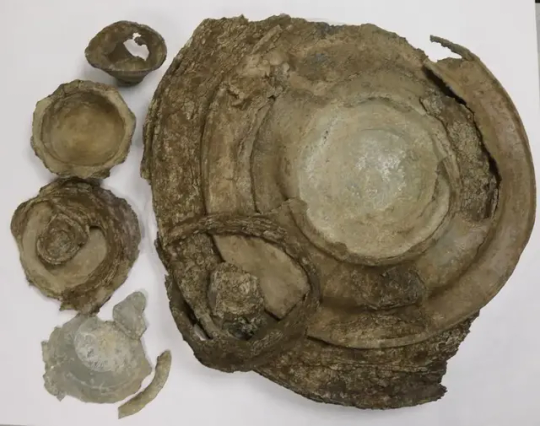

Roman Pewter Hoard Found in Suffolk, England
A rare hoard of Roman pewter has been discovered in Euston, western Suffolk, in eastern England. The rare discovery includes Roman pewter plates, platters, bowls, and a cup.
The vessels’ remains were carefully stacked in a pit, suggesting they were buried as a single group, possibly for safekeeping or as an offering.
The hoard was discovered in Autumn 2022 by local metal detector user, Martin White, whilst taking part in an East of England Rally – an organized detecting event. They are now on display at the West Stow Anglo-Saxon Village and Museum, near Bury St Edmunds, until January 2024.
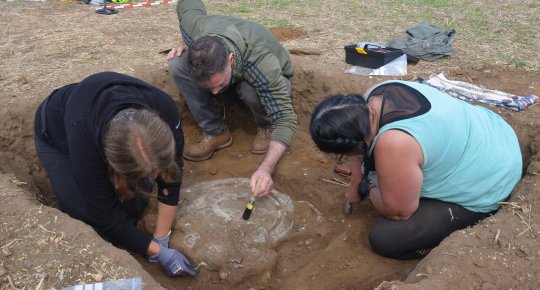
Faye Minter, Suffolk County Council’s Archaeological Archives and Projects Manager, said: “This is a significant discovery. The larger plates and platters were used to allow food to be served communally and the octagonal bowls may have a Christian reference. Similar hoards are found across southern Britain, including from the nearby large Roman settlements at Icklingham and Hockwold.”
Suffolk County Council Archaeological Service facilitated the excavation of the hoard, which was carried out by Wardell Armstrong and Norfolk Museum Service conservators.
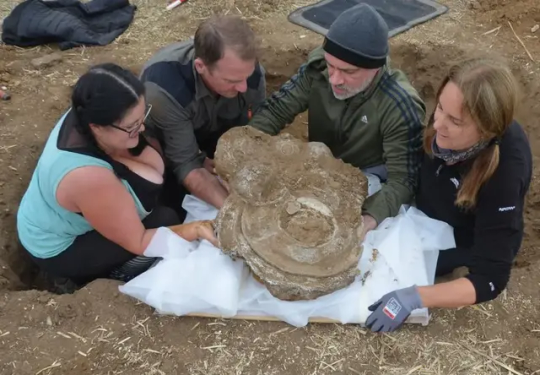
There is evidence of heavy plow damage to the vessels, and advanced corrosion has fused several of them together. The main stack contained five plates and platters nested on top of each other.
All work was funded by the Euston Estate and East of England Rallies.
However, pewter is not a precious metal, this treasure of inestimable archaeological value does not qualify as official treasure and therefore belongs to the property owner.
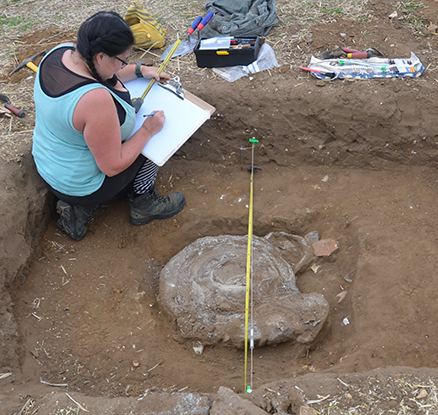
The hoard was discovered on the Euston Estate, making the Duke of Grafton the owner. He donated it to the West Stow Anglo-Saxon Village and Museum, which is located near Bury St Edmunds.
The Duke of Grafton from The Euston Estate, said: “We were happy to donate this hoard and make it available for the public to see. Everyone can then share in the joy of this historic Suffolk find.”
By Oguz Kayra.

#Roman Pewter Hoard Found in Suffolk England#metal detecting#ancient artifacts#archeology#archeolgst#history#history news#ancient history#ancient culture#ancient civilizations#roman history#roman empire#roman art
30 notes
·
View notes